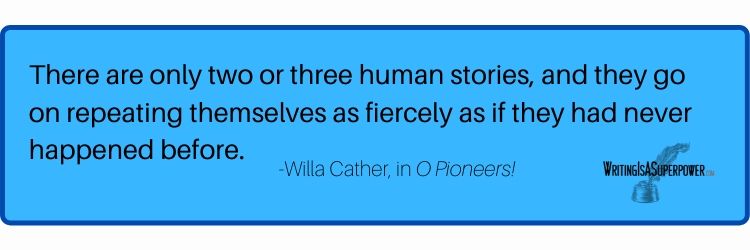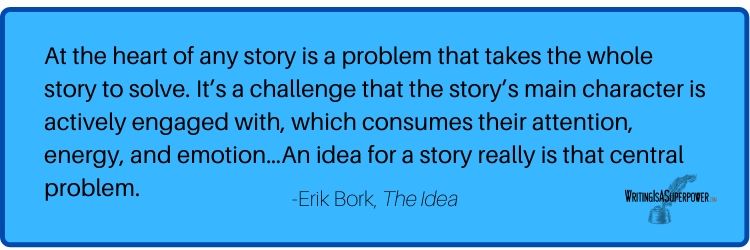
In this article, and the following series, I show you how to write your first novel. Here you’ll find the basics I wish I had known forty years ago when I started writing long fiction.
If you internalize what you learn here and make it your own, writing your first novel can be a rewarding and transformative journey.
Plus, the final draft will be infinitely more enjoyable for the reader. It’ll stand a better chance of succeeding in the marketplace too.
In this post, you’ll discover the basics of a good story and how to avoid being overwhelmed or becoming lost in the writing process.
This first article in the series is an overview of the process. It introduces you to concepts to keep in mind as you envision and plan your first novel.
Later articles in this series will take you deeper into the process of planning and show you, step-by-step, my approach to writing a novel.
Maugham’s 3 Rules for Writing a Novel.
There are three rules for writing a novel. Unfortunately, no one knows what they are.
W. Somerset Maugham, highest-paid novelist of the 1930s
Perhaps in Mr. Maugham’s time no one knew the rules for writing a novel, but that isn’t true today. Now we know.
Today there is an abundance of information on how to best construct an engaging story. While there are many ways to approach your first novel, the method I will show you is one I’ve developed over several decades.
My method is an organic, yet methodical, approach that allows for creativity while also keeping you grounded and on track.
With this method, I think you’ll find you can write your first novel faster than you thought possible.
The Most Difficult Way to Write a Novel.
The most intimidating and challenging way to write a novel is to start at the beginning and write like crazy until you get to the end.
That’s how I wrote my first few novels. It’s madness.
A far more sane and manageable approach is to first plan and plot your story scene by scene on a storyboard.
Once all the scenes are laid out, and the plot is thoroughly tested and proven to work in a logical sequence, divide the writing tasks into sections of about 30 pages.
Then subdivide each 30-page section into about five scenes. Each scene is about six pages long.
Then focus on writing a single 6-page scene at a time. It’s so much easier to write six pages than 250.
With this approach, you’ll avoid becoming overwhelmed, confused, or lost.
In this article, and others in this series, I show you how to build your novel one scene at a time, but first, let’s look at two huge mistakes I hope you’ll avoid as you write your first novel.
Why Novels Fail.
Anyone can write a manuscript, call it a novel, and publish it online. That doesn’t mean people will read it.
Most self-published novels die a quiet, lonely death in the internet’s forgotten corners.
Of the many novels I have tried to read but could not finish, I noticed two common problems.
Common Failings of Unreadable Novels:
- No structure.
- No central, unifying idea.
There are many other things that can doom a novel. However, if the structure is solid and it has a clear central idea, the other issues can probably be corrected with careful revision.
When a novel is not structured in a recognizable form, it will be difficult to read. Just as a sentence must be structured to be understood, so must a novel.

Keep it Simple.
As the author, you must control your story. The more complex your novel becomes, the more difficult it will be to maintain control.
Details introduced early in the story have a way of growing and magnifying. The more characters and elements you have, the more difficult it will be to maintain control as your story evolves.
The best story is always a simple story well told.
Avoid the temptation to over-complicate your novel with too many characters, scenes, and plot devices. That will only confuse the reader and diminish the emotional impact of your story.
Mel Tolkin, a mentor to Carl Reiner, Mel Brooks and Woody Allen, taught the only story that mattered was the story of the human condition and what happens in the human heart.
Regardless of what your story is about, it must ultimately be relatable to humans.
Keep it Short.
For your first novel, I recommend that you keep it short.
A manuscript that is less than 160 pages is considered a novella.
Technically, you could write and publish a story that is more than 160 pages and legitimately call yourself a novelist.
For your first novel, I suggest you plan for 200 to 250 pages. In this series, I assume you’ll be writing a manuscript that is 250 pages, but a shorter novel is perfectly okay too.
Write a Novel Readers Will Enjoy.
The best novels create an emotional experience for the reader.
To paraphrase a line in Blake Snyder’s, Save The Cat, “Story is structure, a precisely made mechanism of emotion.”
You could mindlessly hammer out 250 pages of text just to see if you can do it and call it a novel. Or, you could create an emotionally satisfying experience your reader will love.
Hammering out 250 pages isn’t writing. It’s typing.
Writing a novel can be demanding if you go at it haphazardly.
There are a million things to consider. At times, it might feel like your head will explode. It won’t.
This article will show you a sane approach to writing a novel people will enjoy reading.
Writing long fiction can expand your world, enrich your life, and give you new insights into what it means to be human.
I’ll show you how to do it.

Be a Planner.
Writing a novel is a big, complicated job with a lot of moving parts. Once you accept this truth, the task becomes much easier and rewarding.
In the world of creative writing, you can find two kinds of writers: planners and pantsers.
Pantsers are writers who fly by the seat of their pants. Typically, a pantser will just dive in and start writing, slinging words on the computer screen with joyful abandon.
I began as a pantser, and it took years to write my first published novel. I’m a planner. Planning is better.
If you first plan your novel, you can expect to write it in a year or less.
When you plan a novel, you eliminate most of the stress, angst, and confusion that often plague creatives.
Planning sets your imagination free.
A detailed plan breaks the process into manageable chunks and keeps you on track. It’s like flying with instruments.
Your Multidimensional Mind.
Before we get into the details of writing your first novel, I want to discuss your mind and imagination.
First, let’s look at the obvious. A novel springs from the imagination of the author to enter the mind of the reader.
A novel might sell in the millions, but it remains an intimate experience between the author and the reader.
Remember, a story is linear. It’s written one word at a time, and it’s read one word at a time.
However, when a story emerges in the mind of the author, it’s multidimensional, transcending time, and space.
A story might trickle into the novelist’s imagination in drips and drabs, or it may explode like a supernova spewing seeds of new worlds all over the Universe.
While imagining a novel, the writer could first experience the end of the story or a snippet of dialog that opens the first chapter, or countless details in between.
Story details can tumble out like the contents of a treasure chest, rubies, and gold mixed with bits of rusted iron, sea shells and beach sand.
The point is, a story rarely if ever, presents itself perfect and ready for publication. It comes to the author in pieces mixed with garbage and misleading visions.
Your job as a novelist is to separate the wheat from the chaff and organize the good stuff in an entertaining and emotionally satisfying pattern.

A Novel is a Puzzle.
A novel is a puzzle where you must first imagine the pieces into existence. And, these pieces may come to you at all hours of the day or night.
The subconscious will feed you details about your story for as long as you are open to receiving them. Let them tumble out in any order.
Write them down. Later, as you begin to outline your story, you’ll separate the good from the bad.
Not every detail will be useful; some might belong to another story; others will lead to better ideas.
The trick is to accept everything. Write it down.
If you reject the ideas your subconscious sends to your conscious mind, it will close shop and deny you the good stuff.
Sometimes the best ideas come when you’re off doing other things.
It might feel as if the novel is coming through you, not from you. That’s the mysterious thing about the human mind.
Nobody knows where it is or how it works.
Always have a way to record story ideas and details that come to you. I use a flip-style pocket notebook.
The point I want to make crystal clear is your imagination will give you the story in bits and pieces jumbled with other stuff.
Record these pieces as they come to you.
Later, in the planning process, you’ll organize the fragments into a logical sequence.

Your Story Idea.
As you begin your novel, you’ll need to keep a lot of things in mind. Your notebook will help with this, and so will a storyboard.
I’m also a big fan of sticky notes, and dry erase boards too. More on these later in this series.
A foundational question you will need to answer early in the creative process is, “What is your novel about?”
Earlier I mentioned that a good story is an emotional experience for the reader. That experience begins the moment the reader first discovers your novel.
That initial contact might be a thumbnail image on Amazon, the book’s cover, or your answer when somebody asks about your novel.
It might be the title, but something about your story should capture the attention of the prospective reader, draw them in, and initiate the story’s unfolding.
The moment a prospective reader first sees your novel, they will subconsciously ask themselves, “What’s it about?”
Everything about your story must work together to reveal the answer to their question.
This reveal begins with the book cover and title, proceeds through the novel’s description, and into the story itself, concluding in the last chapter.
If someone asks about your novel, you must be able to answer them in a sentence or two.
The one thing that dictates the cover, title, description, every scene, description, dialogue, and the “about” question is the story idea.
A Good Idea.
The best time to work out the idea of your story is BEFORE YOU WRITE YOUR NOVEL.
Because your mind is multidimensional, working out the idea of your story will be an ongoing thing throughout the planning process and even into the writing process.
However, it’s vital to begin immediately to try to define what your story is about. What’s the idea behind it?
In his book, The Idea, author, and screenwriter, Erik Bork reveals seven elements of a viable story.
Erik Bork’s 7 Elements of a Good Story Idea:
- Punishing
- Relatable
- Original
- Believable
- Life-Altering
- Entertaining
- Meaningful
I won’t expand on these elements here because to do so would probably violate Erik Bork’s copyright. The 7 Elements are the result of his 30 years of writing in Hollywood and belong to him.
You can get a copy of The Idea on Amazon for about $15. I highly recommend you read it. As you read through it, you’ll naturally begin to refine the idea for your novel.
More than any other book about writing and story structure, The Idea will help you avoid the catastrophic mistake of writing a poorly conceived novel.
Incidentally, I have several writing books I revisit as I plan and write a novel. Reading books about writing novels stimulates my imagination and reminds me of details to include in my story.
Work from a Known Point.
As you plan your novel, you’ll have a ton of thoughts about characters, dialogue, scenes, and perhaps a thousand other things.
All of this stuff is moving around in your imagination, and all of it is connected. Change one thing, and you might have to change a hundred more things.
Like a game of Pick Up Sticks, you can’t adjust one detail without impacting everything else. If you don’t know how to handle this continually shifting mass of ideas, you’ll go crazy.
The trick to staying sane and completing a good novel is to always work from a known point.
In the cockpit of a helicopter, an instrument tracks the relationship of the aircraft to the horizon.
It’s called the artificial horizon, or flight indicator, and it shows the bank and pitch of the aircraft.
For the pilot, the artificial horizon is a known point. Helicopters can crash when the pilot ignores this instrument and loses perspective.
As a writer, particularly as you begin your first novel, you must work from a known point, one thing about your story that does not change.
It should be the story idea.
In the beginning, as you generate ideas and plan your novel, it’s okay to be fluid and play with various notions of what your story.
However, work towards clarifying the central unifying idea.
Once you know the idea of your story, what your story is about, use it to determine everything else about your novel.
If ever you feel lost in the writing process, return to the known point, your story idea.
Basic Story Structure.
Structure is the skeleton on which we hang the flesh of our story.
Stories have three parts, a beginning, middle, and end. This pattern of three is familiar to the human psyche.
Morning, noon, and night create the day. Life has three parts too. We grow up, grow old, and die.
Stage plays recognized this pattern with three acts. The film industry refined the three-act structure with more complex plots, but the fundamentals are the same.
As a novelist, you can use the insights of stage plays and movies to build a highly engaging novel your readers will love.
Start with the three-act structure, a beginning, middle, and end.
In a stage play, movie, and novel, these three parts are Act I, Act II, and Act III.
Act II is twice as long as the other two acts.
Because Act II is twice as long as the other two acts, we can divide it in half to create Act IIA and Act IIB.
Now we can see that a story has four equal sections, Act I, Act IIA, Act IIB, and Act III.
If you are planning to a novel that is 250 pages long, you know that each section will have 62.5 pages.
We can divide each section into two parts, thus giving us eight equal story segments of 31 pages.
We will use letters to designate the eight segments: A, B, C, D, E, F, G, and H.
Now, instead of writing 250 pages, a daunting task, you are writing eight short stories, which is a manageable undertaking.
Keep this in mind as we look into story plot and scenes. We’ll come back to structure at the end of this article to see how it all fits together.

The Plot Thickens.
In each of the eight segments that make up your story, something must happen. When strung together throughout your novel, these happenings form a plot.
However, to be effective, your plot must also have structure. Thousands of successful novels, stage plays, and movies reveal a specific and universal story pattern or plot.
The Simplest Plot.
In his book, Plot & Structure, James Scott Bell teaches a simple plot formula he calls LOCK.
The LOCK formula is a Lead character who attempts to achieve an Objective only to be Confronted by an opposing character or force. A Knockout ending resolves the conflict.
The LOCK formula is plot reduced to the absolute minimum. It unveils the essentials and reveals the conflict is at its core.
You can use Bell’s LOCK formula to write an entertaining novel. In some genre’s this may be all you need.
However, a more complex plot structure creates a richer and more rewarding experience for the reader.
For now, let’s look at conflict.
Conflict is Essential.
For a plot to work, there must be conflict.
In real life, many of us prefer to avoid conflict. However, in storyland, conflict is essential.
Imagine a happily married couple at a fine restaurant. They are mindlessly chatting about empty pleasantries.
“How was your day?” He said.
“Fine,” she said. “How was your day?”
“Fine,” he said.
“That’s good.”
If we kept going in this vein, you will either fall asleep or slice your wrists. It’s dull and boring because there is no conflict.
But, let’s turn the screws on the poor guy and add a dash of conflict.
“Honey,” she said. “Is that lipstick on your collar? You smell like cheap perfume.”
“Bob’s secretary gave me a hug as I left the office.”
“Did she take your wedding band too?” She points to the bare shadow on his ring finger.
Now we have conflict. The wife is determined to expose the affair; the husband is determined to conceal it. Only one can win.
Another way to visualize conflict is to imagine a football game. Two teams face each other on the field; only one can win.
That’s conflict.
Conflict keeps the reader engaged.

Beware True Life Stories.
You might be tempted to write a novel about something that happened to you in real life and recount it just as it occurred.
That would probably be a mistake.
Back in my writing workshop days, a student would write a story about something that happened to them. Their story usually bored the class to tears.
When we commented about the dull story, the exasperated writer would typically argue, “But, it really happened!”
And maybe it did happen, but that fact does not make it an engaging story.
There are at least two reasons why real-life experiences do not work as novels.
First, regardless of what happened, the experience was an emotional event for the people involved. If you write about it as it happened, you cannot create the same emotional experience for the reader.
Second, real-life events do not follow story structure. Structure is essential to creating an engaging and satisfying experience for the reader.
If you want to write about a real-life event that happened to you, use it as inspiration for a novel, but be flexible. Be prepared to change your real-life story to make it more engaging.

Plan and Write Scene by Scene.
The fundamental building block of a novel is the scene. A scene is a mini-story with a beginning, middle, and end.
And, like the larger story, scenes have conflict.
Earlier, we saw how we can divide a story into eight equal sections and that in a 250-page novel manuscript, each part was 31 pages long.
Let’s drill down even deeper, shall we?
Each section includes about five scenes. Each scene is about six pages long. The precise number of scenes and their length are flexible.
Now, instead of facing the monumental task of writing a 250-page manuscript, you write a 6-page scene!
When you build your novel one scene at a time, in short segments of approximately six pages, you are never overwhelmed.
Remember, each scene must flow seamlessly into the next. To achieve fluid continuity, we plan out all the scenes before we begin writing.
What We’ve Covered So Far.
In this article, we covered the basics you need to know before writing your first novel, the importance of structure, and how a viable story idea is essential.
We also covered how to break the task of writing a novel into logical bite-sized chunks of about six pages and why it’s crucial to build your story one scene at a time.
In the next article, I’ll define as scene and show you how to use a storyboard to plan and organize your novel before you begin writing.


